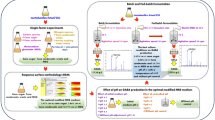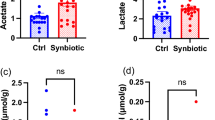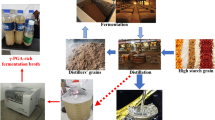Abstract
Gamma-aminobutyric acid (GABA) is a non-proteinogenic amino acid, which has a variety of well-characterized beneficial physiological functions. In order to improve GABA levels and the fermentation process of Thai fermented shrimp (Kung-Som), autochthonous Lactobacillus futsaii CS3 was inoculated as a starter culture into Kung-Som, and its effects on the quality of Kung-Som were studied. The optimal conditions for GABA production in Kung-Som as obtained by response surface methodology (RSM) using a central composite design (CCD) were an inoculum size of roughly 107 CFU/g (X1) of L. futsaii cells together with the addition of 0.5% (w/w) monosodium glutamate (MSG) (X2), resulting in maximum GABA levels of 10,500 mg per kg fresh product. Under these optimized conditions, the experimental GABA content of Kung-Som with an added starter culture was up to four times higher than that of the control (without starter culture) or commercial Kung-Som products (10,120 mg/kg product). Kung-Som produced by inoculation with L. futsaii CS3 but without addition of MSG showed a considerably increased GABA content of 7790 mg/kg compared to the control. Fermentation time was reduced to less than 1 week for these samples compared to the control batches, which took up to 19 days. Polymerase chain reaction denaturing gradient gel electrophoresis (PCR-DGGE) revealed that L. futsaii CS3 remained prominently throughout the Kung-Som fermentation, and that lactic acid bacteria (LAB) rapidly dominated the total microflora because of this inoculation with L. futsaii CS3. Kung-Som samples with starter culture were accepted as well as commercial ones by 30 panelists (p > 0.05). In conclusion, L. futsaii CS3 is a good starter culture for GABA production, resulting in, improved microbiological safety as well as reduced fermentation time.
Graphical Abstract





Similar content being viewed by others
References
Armenta RE, Guerrero-Legarreta I (2009) Stability studies on astaxanthin extracted from fermented shrimp byproducts. J Agric Food Chem 57:6095–6100. doi:10.1021/jf901083d
Association of Official Analytical Chemists (AOAC) (2005) Official methods of analysis, 18th edn. AOAC International, Virginia
Baka AM, Papavergou EJ, Pragalaki T, Bloukas JG, Kotzekidou P (2011) Effect of selected autochthonous starter cultures on processing and quality characteristics of Greek fermented sausages. LWT Food Sci Technol 44:54–61. doi:10.1016/j.lwt.2010.05.019
Barrett E, Ross RP, O’Toole PW, Fitzgerald GF, Stanton C (2012) γ-Aminobutyric acid production by culturable bacteria from the human intestine. J Appl Microbiol 113:411–417. doi:10.1111/j.1365-2672.2012.05344.x
Casquete R, Benito MJ, Martín A, Ruiz-Moyano S, Aranda E, Córdoba MG (2012) Microbiological quality of salchichón and chorizo, traditional Iberian dry-fermented sausages from two different industries, inoculated with autochthonous starter cultures. Food Control 24:191–198. doi:10.1016/j.foodcont.2011.09.026
Daul CB, Slattery M, Reese G, Lehrer SB (1994) Identification of the major brown shrimp (Penaeus aztecus) allergen as the muscle protein tropomyosin. Int Arch Allergy Immunol 105:49–55. doi:10.1159/000236802
Dhakal R, Bajpai VK, Baek KH (2012) Production of GABA (γ- aminobutyric acid) by microorganisms: a review. Braz J Microbiol 43:230–1241. doi:10.1590/S1517-83822012000400001
Diana M, Quílez J, Rafecas M (2014) Gamma-aminobutyric acid as a bioactive compound in foods: a review. J Funct Foods 10:407–420. doi:10.1016/j.jff.2014.07.004
Djenane D, Martínez L, Blanco D, Yanguela J, Yanguela JA, Roncales P (2005) Effect of lactic acid bacteria on extention of shelf life and growth of Listeria monocytogenes in beef steaks stored in CO2-rich atmosphere. Braz J. Microbiol 36:405–412. doi:10.1590/S1517-83822005000400018
Freire AL, Ramos CL, Schwan RF (2015) Microbiological and chemical parameters during cassava based-substrate fermentation using potential starter cultures of lactic acid bacteria and yeast. Food Res Int 76(Part 3):787–795. doi:10.1016/j.foodres.2015.07.041
Gelman A, Drabkin V, Glatman L (2000) Evaluation of lactic acid bacteria, isolated from lightly preserved fish products, as starter cultures for new fish-based food products. Innov Food Sci Emer Technol 1:219–226. doi:10.1016/S1466-8564(00)00023-0
Li H, Cao Y (2010) Lactic acid bacterial cell factories for gamma-aminobutyric acid. Amino Acids 39:1107–1116. doi:10.1007/s00726-010-0582-7
Ratanaburee A, Kantachote D, Charernjiratrakul W, Sukhoom A (2013) Enhancement of γ-aminobutyric acid (GABA) in Nham (Thai fermented pork sausage) using starter cultures of Lactobacillus namurensis NH2 and Pediococcus pentosaceus HN8. Int J Food Microbiol 167:170–176. doi:10.1016/j.ijfoodmicro.2013.09.014
Sanchart C, Benjakul S, Rattanaporn O, Haltrich D, Maneerat S (2015) Efficiency of the V3 region of 16 S rDNA and the rpoB gene for bacterial community detection in Thai traditional fermented shrimp (Kung-Som) using PCR-DGGE techniques. Songklanakarin J Sci Technol 37:291–297
Sanchart C, Rattanaporn O, Haltrich D, Phukpattaranont P, Maneerat S (2016) Technological and safety properties of newly isolated GABA-producing Lactobacillus futsaii strains. J Appl Microbiol 121:734–745. doi:10.1111/jam.13168
Sanchart C, Rattanaporn O, Haltrich D, Phukpattaranont P, Maneerat S (2017) Lactobacillus futsaii CS3, a new GABA-producing strain isolated from Thai fermented shrimp (Kung-Som). Indian. J Microbiol 57:211–217. doi:10.1007/s12088-016-0632-2
Seok JH, Park KB, Kim YH, Bae MO, Lee MK, Oh SH (2008) Production and characterization of kimchi with enhanced levels of gamma-aminobutyric acid. Food Sci Biotechnol 17:940–946.
Shi F, Li Y (2011) Synthesis of γ-aminobutyric acid by expressing Lactobacillus brevis-derived glutamate decarboxylase in the Corynebacterium glutamicum strain ATCC 13032. Biotechnol Lett 33:2469–2474. doi:10.1007/s10529-011-0723-4
Speranza B, Racioppo A, Beneduce L, Bevilacqua A, Sinigaglia M, Corbo MR (2017) Autochthonous lactic acid bacteria with probiotic aptitudes as starter cultures for fish-based products. Food Microbiol 65:244–253. doi:10.1016/j.fm.2017.03.010
Sui C, Liang J, Wang F, Liu J (2016) Cloning and bioinformatics analysis of a glutamate decarboxylase from Lactobacillus plantarum LpS2. Biomed Res ISSN: 0976–1683
Tajabadi N, Ebrahimpour A, Baradaran A, Rahim RA, Mahyudin NA, Manap MYA, Bakar FA, Saari N (2015) Optimization of γ-Aminobutyric Acid Production by Lactobacillus plantarum Taj-Apis362 from Honeybees. Molecules 20:6654–6669. doi:10.3390/molecules20046654
Terzić-Vidojević A, Tonković K, Leboš Pavunc A, Beganović J, Strahinić I, Kojić M, Veljović K, Golić N, Kos B, Čadež N, Gregurek L, Šušković J, Raspor P, Topisirović L (2015) Evaluation of autochthonous lactic acid bacteria as starter cultures for production of white pickled and fresh soft cheeses. LWT - Food Sci Technol 63:298–306. doi:10.1016/j.lwt.2015.03.050
Thai Industrial Standards Institute (TISI) (2014) Standard of Thai Industrial Standards Institute: Fermented shrimp (Kung-Som) TSI 1032–2014. Ministry of Industry, Thailand (in Thai)
Wanangkarn A, Liu DC, Swetwiwathana A, Tan FJ (2012) An innovative method for the preparation of mum (Thai fermented sausages) with acceptable technological quality and extended shelf-life. Food Chem 135:515–521. doi:10.1016/j.foodchem.2012.04.118
Xu N, Wei L, Liu J (2017) Biotechnological advances and perspectives of gamma-aminobutyric acid production. World J Microbiol Biotechnol 33:64. doi:10.1007/s11274-017-2234-5
Zeng X, Xia W, Jiang Q, Yang F (2013) Effect of autochthonous starter cultures on microbiological and physico-chemical characteristics of Suan yu, a traditional Chinese low salt fermented fish. Food Control 33:344–351. doi:10.1016/j.foodcont.2013.03.001
Acknowledgements
This study was financially supported by the Thailand Research Fund through the Royal Golden Jubilee Ph.D. Program (Grant No. PHD/0060/2556) and Shell Centennial Education Fund, Shell Companies in Thailand. Some part of this research work was supported by the ASEAN-European Academic Network (ASEAN-UNINET). The authors thank the Scientific Equipment Center, Prince of Songkla University, Hat Yai, Songkhla, Thailand for their excellent technical assistance.
Funding
This study was funded by the Thailand Research Fund through the Royal Golden Jubilee Ph.D Program (Grant Number PHD/0060/2556). This study was funded by Shell Centennial Education Fund, Shell Companies in Thailand. This study was funded by the ASEAN-European Academic Network (ASEAN-UNINET).
Author information
Authors and Affiliations
Corresponding author
Ethics declarations
Conflict of interest
The authors declare that they have no conflict of interest.
Ethical approval
This article does not contain any studies with human participants or animals performed by any of the authors.
Informed consent
Informed consent was obtained from all individual participants included in the study.
Rights and permissions
About this article
Cite this article
Sanchart, C., Rattanaporn, O., Haltrich, D. et al. Enhancement of gamma-aminobutyric acid (GABA) levels using an autochthonous Lactobacillus futsaii CS3 as starter culture in Thai fermented shrimp (Kung-Som). World J Microbiol Biotechnol 33, 152 (2017). https://doi.org/10.1007/s11274-017-2317-3
Received:
Accepted:
Published:
DOI: https://doi.org/10.1007/s11274-017-2317-3




